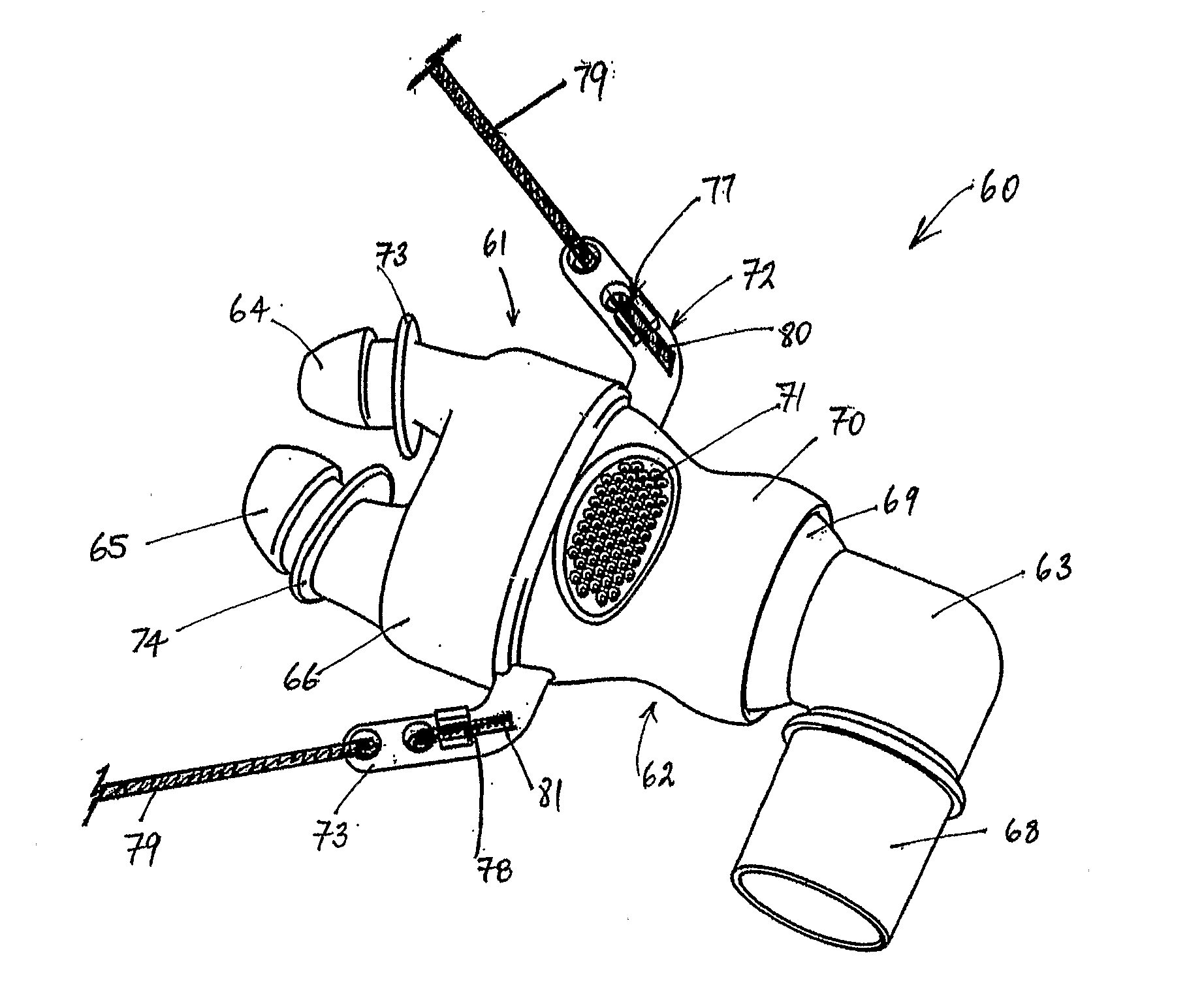Breathing Assistance Apparatus
a technology for osa and apparatus, which is applied in the direction of respirators, artificial respiration, therapy, etc., can solve the problems cumbersome headgear, and discomfort of patients, and achieves the effects of increasing treatment compliance, being comfortable to wear, and being convenient to us
- Summary
- Abstract
- Description
- Claims
- Application Information
AI Technical Summary
Benefits of technology
Problems solved by technology
Method used
Image
Examples
first embodiment
[0043]a nasal cannula of the present invention is shown in detail in FIGS. 2 to 6. Referring to FIGS. 2 and 6, the nasal cannula 2 comprises three main components; the prong part 21, body part 22 and ball connector 23.
[0044]The prong part 21 has two nasal prongs 24, 25, each of which are substantially shaped to follow the contours of the human nares and in use are placed inside a user's nares. The prongs 24, 25 extend out from a hollow tubular body 26 that in use fits to the body part 22. Each of the prongs 24, 25 are integrally moulded with the tubular body 26 in a flexible plastics material or rubber, such as silicone, other thermoset elastomers or thermoplastic elastomers such as Kraton™. The prongs 24, 25 are substantially oval tubular members that allow for a passage of gases. In particular, as shown in FIG. 5, the prongs are oval in shape and angled in the same manner as a human's nares. The prongs 24, 25 are angled toward one another (or toward the vertical axis Y) at the top...
second embodiment
[0053]the present invention is shown in FIG. 7. In this embodiment of the nasal cannula 42 the prongs 43, 44 are preferably small bore prongs for use with lower flow conditions. The prongs 43, 44 are similarly shaped to the prongs 24, 25 detailed above, but may not seal in the same manner as the abovementioned prongs due to the smaller size of the prongs. In fact these prongs may not seal at all in use within the user's nares.
[0054]Furthermore, in this second embodiment the nasal cannula 42 is smaller and weighs less as it is only comprised of a prong body 45 and prongs 43, 44, where the body 45 is connected to a small tube that is formed with corrugations or bellows 48 that connect to an inspiratory tube or conduit 47 (similar to the inspiratory conduit 3 described above) that receives a supply of gases.
[0055]The corrugations of bellows 48 will bend or move when a weight or force is placed on the cannula, thereby preventing dislodgement of the cannula 42 from a user's face in use. ...
third embodiment
[0058]the nasal cannula of the present invention is shown in FIG. 8 where the cannula may be provided with corrugated or baffled sections on the prongs. The nasal cannula 49 of this embodiment is similar to that of FIG. 2 but the prongs 50, 51 have a series of corrugations 52, 53 formed in them. The corrugations 52, 53 allow for movement of each of the prongs 50, 51 for a better user fit, and allow for movement of the cannula 49 without causing dislodgement of the prongs from the user's nares.
Angled Prong Nasal Cannula
PUM
 Login to View More
Login to View More Abstract
Description
Claims
Application Information
 Login to View More
Login to View More - R&D
- Intellectual Property
- Life Sciences
- Materials
- Tech Scout
- Unparalleled Data Quality
- Higher Quality Content
- 60% Fewer Hallucinations
Browse by: Latest US Patents, China's latest patents, Technical Efficacy Thesaurus, Application Domain, Technology Topic, Popular Technical Reports.
© 2025 PatSnap. All rights reserved.Legal|Privacy policy|Modern Slavery Act Transparency Statement|Sitemap|About US| Contact US: help@patsnap.com



